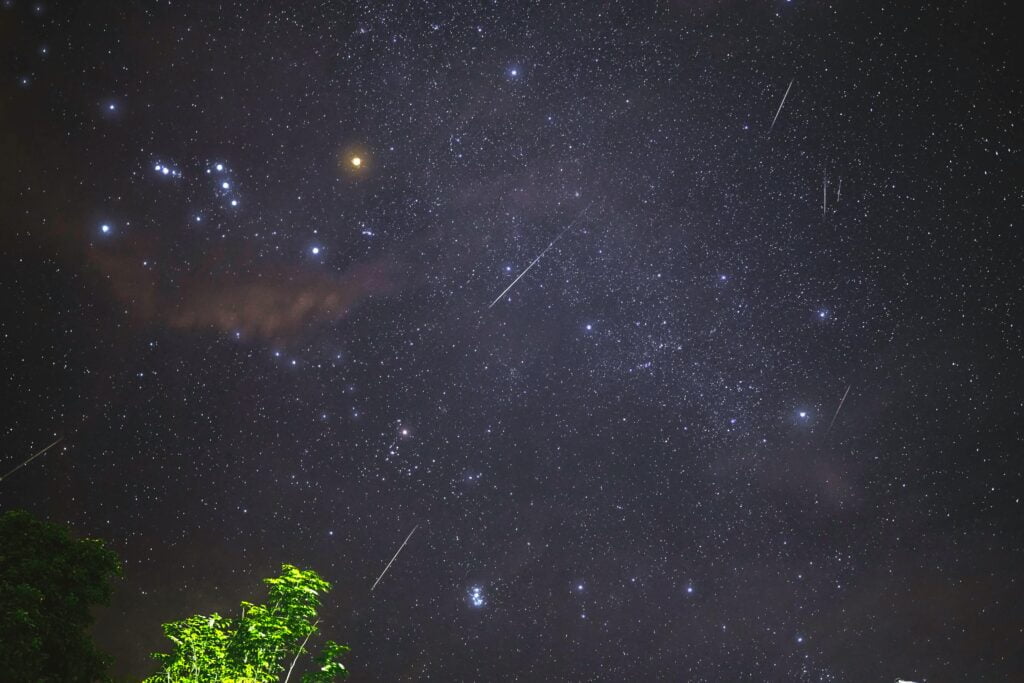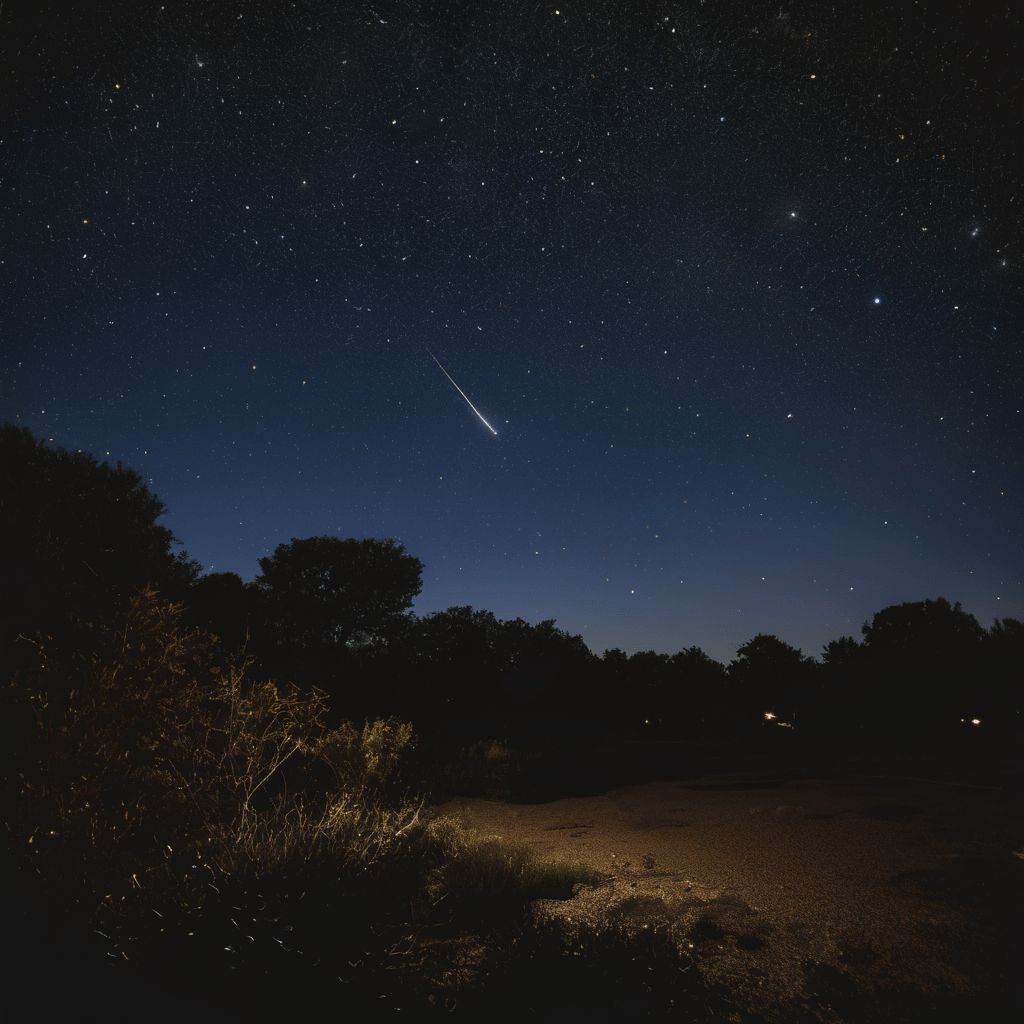This is a guide to seeing the most intense meteor shower of the year: the Perseid Meteor Shower. Known for its stunning display of meteors and fireballs, this meteor shower offers a spectacular show for stargazers and astrophotography enthusiasts alike. This short guide will prepare you with everything you need to know to make the most of this mesmerising event.

Contents
What is the Perseid Meteor Shower?
When Will the Perseids Peak?
Where To See The Perseid Meteor Shower
Where to Look for the Perseid Meteor Shower
The Best Time to View the Perseids
How to Photograph the Perseid Meteor Shower
1. Choosing a DSLR Camera
2. Choosing the right lens
3. Camera Settings
4. The Technique and Post-processing
Caution
Final Tips
What is the Perseid Meteor Shower
A meteor shower is a celestial event in which streams of debris floating in space, left behind by some asteroid or comet, are pulled towards the Earth due to its gravity. The debris particles fall towards the Earth at such speeds that they start to burn due to the friction with air creating bright streaks of light, thus they become meteors or “shooting stars”.The Perseid meteor shower is caused by the Earth passing through the debris left behind by the comet Swift-Tuttle. It’s called the Perseid because of the area in the sky from which the meteors appear to radiate, known as the radiant. The radiant for this meteor shower lies in the constellation Perseus.
Meteor showers happen throughout the year and are named similarly on the basis of their radiants like the Orionids that have their radiant in Orion or the Geminids that have their point of origin in the constellation of Gemini. But Perseids are the most prolific of the year due to their high meteor per hour rate.
When Will the Perseids Peak?
According to the American Meteor Society, the Perseid Meteor Showers in 2024, the Perseids start from July 14th 2024 to September 1st 2024. They are expected to peak during the pre-dawn hours of August 12 and August 13. The peak is when the meteor shower is at its highest intensity. Thus during August 12 and August 13, you can expect to see between 50 to 100 meteors per hour, provided that you are in a dark location under clear skies.
Where To See The Perseid Meteor Shower
To get the best view of the Perseid Meteor Shower, head to a location with minimal light pollution. You can use the light pollution map to find out the area with the least light pollution. Light Pollution is generally indicated by the Bortle scale. Find an area where the Bortle number is 4 or less. But to have a memorable experience of the Perseid Meteor Shower, you will have to get out of the city lights to ensure that you will be able to see the Perseid Meteors. Staying in the city looking for meteors will not help much and you’ll only be able to catch one or two unusually bright Perseid meteors. Good places to go to would be:
- Rural Areas
- National Parks
- Mountains
- Deserts
- Dark Beaches
- Designated Dark Sky Reserves

Where to Look for the Perseid Meteor Shower
For optimal viewing, find a spot to lie down and comfortably gaze up at the sky. The Perseid meteors will radiate from the constellation Perseus, which will be in the northeastern part of the sky. However, meteors can appear anywhere, so a wide view of the sky is advantageous. Bring a reclining chair, and give your eyes about 20-30 minutes to adjust to the dark.
Finding the Radiant Point for the Perseid Meteor Shower
The Perseid meteors radiate from the constellation Perseus in the northeastern sky:
- Locate Cassiopeia: Find the “W” shape of Cassiopeia. This constellation is usually easier to find and can serve as a guide.
- Find Perseus: Perseus is located below and to the right of Cassiopeia. It is characterised by a grouping of stars that form a shape resembling a distorted Y.
You can use the app called Stellarium to direct you to the constellation of Perseus.

The Best Time to View the Perseids
The Perseid meteor shower is typically best viewed during its peak, which usually occurs around August 11-13 each year. The best time to watch the Perseids is during the pre-dawn hours, from around midnight to dawn, when the sky is darkest, and the meteors are most visible.
For 2024, the peak of the Perseid meteor shower is expected around the night of August 12 and early morning of August 13. Since the moon will be waning crescent, its light will not significantly affect visibility, providing excellent conditions for meteor watching.
How to Photograph the Perseid Meteor Shower
Photographing meteors, particularly during the Perseid Meteor Shower, can be an immensely rewarding experience.
DISCLAIMER: As an Amazon associate, I make commissions from qualified purchases. That is when you make a purchase using the links below, I earn a small commission at no extra cost to you. Thus by buying from the links of the products below you can help in supporting this website. That being said, the recommended products are from my personal experience and are in no way affected by the affiliate program.
Camera
To start you will need a DSLR Camera. There are many DSLR Cameras suitable for all budgets available nowadays, Check out our guide to buying the best budget DSLR Camera. If you don’t have one, I will recommend buying the Canon EOS 2000D/ Rebel T7 Camera as it is affordable and offers great results while being intuitive and easy to use. The main thing to consider when shooting for the meteor shower is the lens. Make sure to bring a wide-angle lens with a small f ratio so that maximum light can be sensed by the camera.
Lens
The most important aspect of capturing astrophotos and spectacular meteors is the lens. For nightscapes, pictures of the Milky Way, and meteor showers, choose a wide-angle lens. A fish eye lens is a lens with an extra wide angle that is used for photographing large parts of the sky. Popular lenses are listed below:
High-end:
Mid-range:
Rokinon 14mm f/2.8 (highest rated),
Fish-eye lens:
Rokinon 12mm F2.8 Full Frame Fisheye
Camera Settings
- Manual Mode: Switch your camera to manual mode.
- Focus: Manually set the focus to infinity. Use live view and zoom in on a bright star to fine-tune focus.
- ISO: Set your ISO between 1600 and 3200, balancing sensitivity and noise.
- Aperture: Open the aperture as wide as possible (f/2.8 or wider) to capture more light.
- Shutter Speed: Start with a 20-second exposure and adjust based on your results. Avoid star trails by using the rule of 500 (500 divided by the focal length of your lens = maximum exposure time in seconds).
- White Balance: Set to auto or experiment with different settings to achieve your desired effect.
Technique
Use continuous shooting mode or an intervalometer to take multiple shots in succession, increasing your chances of capturing a meteor. Use an exposure of 20 seconds or more proportionate to the focal length of your lens. A longer exposure will increase the chances of capturing a meteor. Make sure the camera and lens are on a sturdy tripod. Periodically review your shots to ensure the settings are correct and make adjustments as needed. You can then stack the meteor-containing images into a single image with many meteors in a single frame. Post-processing is also important: use software like Adobe Photoshop or specialised astrophotography software to stack multiple images. I personally use the free image processing software called GIMP which reduces noise and enhances meteor visibility. Adjust brightness, contrast, and colour balance to bring out the details of the meteors and the night sky.

Caution
Going out to watch meteors is exciting, but don’t expect to see meteors as soon as you look up at the night sky. Watching a meteor shower requires some patience. You will need 15 to 20 minutes for your eyes to adapt to the darkness. That means you won’t be using your phone either. Rather than standing and bending your neck consistently to look up, lie down somewhere safe and relax as you will be spending quite a lot of time gazing at the night sky. Make sure that you can see the maximum amount of area of the night sky as a meteor can come from anywhere.
That being said, watching the Perseid meteor shower is an enriching experience. Because of its high intensity, there is less waiting time between meteors and you might even be able to glimpse some fireballs, which are extremely bright meteors with long tails that persist for a few moments.

Final Tips
- Be Patient: Meteor showers require patience. Plan to spend several hours outside for the best experience.
- Stay Warm: August nights can be chilly, especially in rural or high-altitude locations. Dress warmly and bring blankets.
- Bring Snacks and Drinks: Staying hydrated and nourished will help you stay comfortable during your skywatching session.
- Check the Weather: Clear skies are essential. Check the weather forecast in advance and be prepared to change locations if necessary.
- Bring a mosquito repellant: At this time of the year, bugs and mosquitoes are rampant. Make sure to bring an anti-mosquito lotion or spray with you.
Seeing and photographing the Perseid Meteor Shower is a magical experience that combines the beauty of nature with the art of astrophotography. With the right preparation and a bit of patience, you can capture stunning images of this celestial event and create memories that will last a lifetime.


I discovered your blog site on google and check a few of your early posts. Continue to keep up the very good operate. I just additional up your RSS feed to my MSN News Reader. Seeking forward to reading more from you later on!…